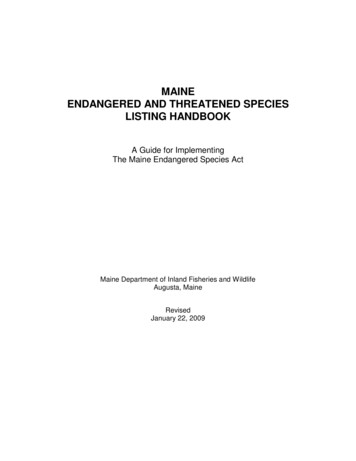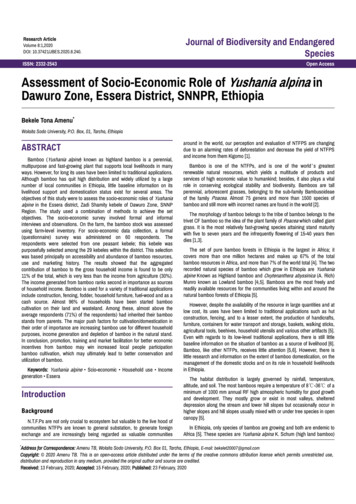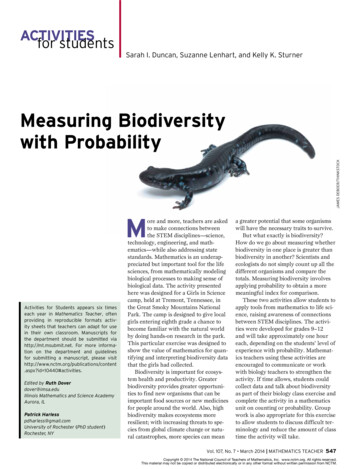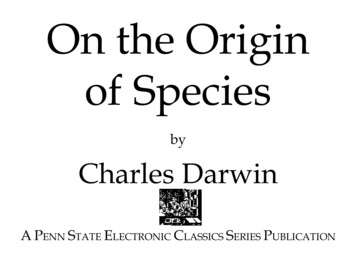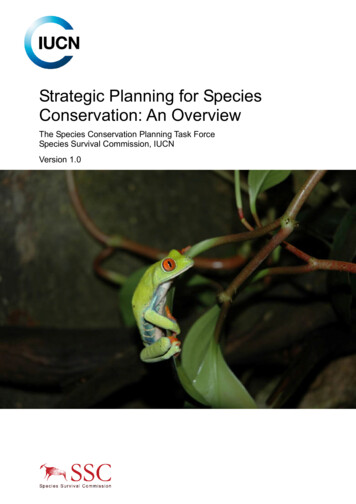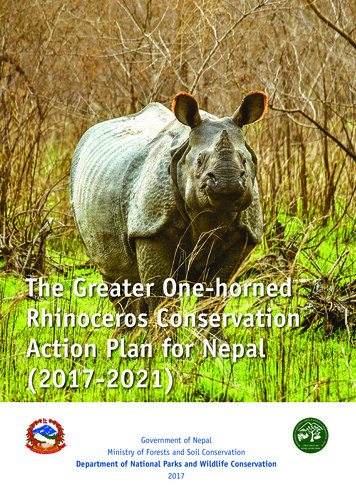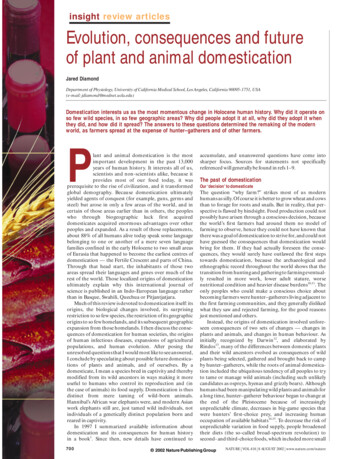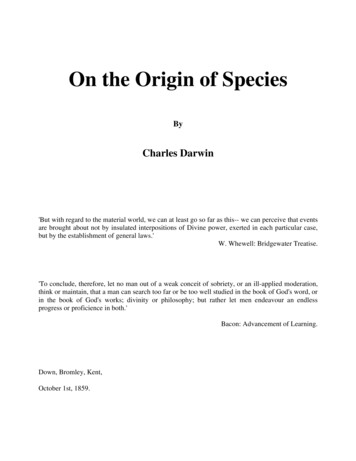
Transcription
On the Origin of SpeciesByCharles Darwin'But with regard to the material world, we can at least go so far as this-- we can perceive that eventsare brought about not by insulated interpositions of Divine power, exerted in each particular case,but by the establishment of general laws.'W. Whewell: Bridgewater Treatise.'To conclude, therefore, let no man out of a weak conceit of sobriety, or an ill-applied moderation,think or maintain, that a man can search too far or be too well studied in the book of God's word, orin the book of God's works; divinity or philosophy; but rather let men endeavour an endlessprogress or proficience in both.'Bacon: Advancement of Learning.Down, Bromley, Kent,October 1st, 1859.
On the Origin of Species by Means of Natural Selection, or the Preservation ofFavoured Races in the Struggle for Life.By Charles DarwinContentsIntroductionChapter IVariation under DomesticationCauses of Variability -- Effects of Habit -- Correlation of Growth -- Inheritance -- Character ofDomestic Varieties -- Difficulty of distinguishing between Varieties and Species -- Origin ofDomestic Varieties from one or more Species -- Domestic Pigeons, their Differences and Origin -Principle of Selection anciently followed, its Effects -- Methodical and Unconscious Selection -Unknown Origin of our Domestic Productions -- Circumstances favourable to Man's power ofSelection.Chapter IIVariation under NatureVariability -- Individual Differences -- Doubtful species -- Wide ranging, much diffused, andcommon species vary most -- Species of the larger genera in any country vary more than thespecies of the smaller genera -- Many of the species of the larger genera resemble varieties in beingvery closely, but unequally, related to each other, and in having restricted ranges.Chapter IIIStruggle for ExistenceBears on natural selection -- The term used in a wide sense -- Geometrical powers of increase -Rapid increase of naturalised animals and plants -- Nature of the checks to increase -- Competitionuniversal -- Effects of climate -- Protection from the number of individuals -- Complex relations ofall animals and plants throughout nature -- Struggle for life most severe between individuals andvarieties of the same species; often severe between species of the same genus -- The relation oforganism to organism the most important of all relations.Chapter IVNatural SelectionNatural Selection -- its power compared with man's selection -- its power on characters of triflingimportance -- its power at all ages and on both sexes -- Sexual Selection -- On the generality ofintercrosses between individuals of the same species -- Circumstances favourable and unfavourableto Natural Selection, namely, intercrossing, isolation, number of individuals -- Slow action -Extinction caused by Natural Selection -- Divergence of Character, related to the diversity ofinhabitants of any small area, and to naturalisation -- Action of Natural Selection, throughDivergence of Character and Extinction, on the descendants from a common parent -- Explains theGrouping of all organic beings.
Chapter VLaws of VariationEffects of external conditions -- Use and disuse, combined with natural selection; organs of flightand of vision -- Acclimatisation -- Correlation of growth -- Compensation and economy of growth - False correlations -- Multiple, rudimentary, and lowly organised structures variable -- Partsdeveloped in an unusual manner are highly variable: specific characters more variable thangeneric: secondary sexual characters variable -- Species of the same genus vary in an analogousmanner -- Reversions to long-lost characters -- Summary.Chapter VIDifficulties on TheoryDifficulties on the theory of descent with modification -- Transitions -- Absence or rarity oftransitional varieties -- Transitions in habits of life -- Diversified habits in the same species -Species with habits widely different from those of their allies -- Organs of extreme perfection -Means of transition -- Cases of difficulty -- Natura non facit saltum -- Organs of small importance - Organs not in all cases absolutely perfect -- The law of Unity of Type and of the Conditions ofExistence embraced by the theory of Natural Selection.Chapter VII InstinctInstincts comparable with habits, but different in their origin -- Instincts graduated -- Aphides andants -- Instincts variable -- Domestic instincts, their origin -- Natural instincts of the cuckoo,ostrich, and parasitic bees -- Slave-making ants -- Hive-bee, its cell-making instinct - - Difficultieson the theory of the Natural Selection of instincts -- Neuter or sterile insects -- Summary.Chapter VIII HybridismDistinction between the sterility of first crosses and of hybrids -- Sterility various in degree, notuniversal, affected by close interbreeding, removed by domestication -- Laws governing thesterility of hybrids -- Sterility not a special endowment, but incidental on other differences -Causes of the sterility of first crosses and of hybrids -- Parallelism between the effects of changedconditions of life and crossing -- Fertility of varieties when crossed and of their mongrel offspringnot universal -- Hybrids and mongrels compared independently of their fertility -- Summary.Chapter IXOn the Imperfection of the Geological RecordOn the absence of intermediate varieties at the present day -- On the nature of extinct intermediatevarieties; on their number -- On the vast lapse of time, as inferred from the rate of deposition and ofdenudation -- On the poorness of our palaeontological collections -- On the intermittence ofgeological formations -- On the absence of intermediate varieties in any one formation -- On the
sudden appearance of groups of species -- On their sudden appearance in the lowest knownfossiliferous strata.Chapter XOn the Geological Succession of Organic BeingsOn the slow and successive appearance of new species -- On their different rates of change -Species once lost do not reappear -- Groups of species follow the same general rules in theirappearance and disappearance as do single species -- On Extinction -- On simultaneous changes inthe forms of life throughout the world -- On the affinities of extinct species to each other and toliving species -- On the state of development of ancient forms -- On the succession of the sametypes within the same areas -- Summary of preceding and present chapters.Chapter XIGeographical DistributionPresent distribution cannot be accounted for by differences in physical conditions -- Importance ofbarriers -- Affinity of the productions of the same continent -- Centres of creation -- Means ofdispersal, by changes of climate and of the level of the land, and by occasional means -- Dispersalduring the Glacial period co-extensive with the world.Chapter XII Geographical Distribution -- continuedDistribution of fresh-water productions -- On the inhabitants of oceanic islands -- Absence ofBatrachians and of terrestrial Mammals -- On the relation of the inhabitants of islands to those ofthe nearest mainland -- On colonisation from the nearest source with subsequent modification -Summary of the last and present chapters.Chapter XIII Mutual Affinities of Organic Beings: Morphology: Embryology: RudimentaryOrgansClassification, groups subordinate to groups -- Natural system -- Rules and difficulties inclassification, explained on the theory of descent with modification -- Classification of varieties -Descent always used in classification -- Analogical or adaptive characters -- Affinities, general,complex and radiating -- Extinction separates and defines groups -- Morphology, between membersof the same class, between parts of the same individual -- Embryology, laws of, explained byvariations not supervening at an early age, and being inherited at a corresponding age -Rudimentary Organs; their origin explained -- Summary.Chapter XIV Recapitulation and ConclusionRecapitulation of the difficulties on the theory of Natural Selection -- Recapitulation of the generaland special circumstances in its favour -- Causes of the general belief in the immutability of species
-- How far the theory of natural selection may be extended -- Effects of its adoption on the study ofNatural history -- Concluding remarks.
On the Origin of Species.Introduction.When on board H.M.S. 'Beagle,' as naturalist, I was much struck with certain facts in thedistribution of the inhabitants of South America, and in the geological relations of the present to thepast inhabitants of that continent. These facts seemed to me to throw some light on the origin ofspecies--that mystery of mysteries, as it has been called by one of our greatest philosophers. Onmy return home, it occurred to me, in 1837, that something might perhaps be made out on thisquestion by patiently accumulating and reflecting on all sorts of facts which could possibly haveany bearing on it. After five years' work I allowed myself to speculate on the subject, and drew upsome short notes; these I enlarged in 1844 into a sketch of the conclusions, which then seemed tome probable: from that period to the present day I have steadily pursued the same object. I hopethat I may be excused for entering on these personal details, as I give them to show that I have notbeen hasty in coming to a decision.My work is now nearly finished; but as it will take me two or three more years to complete it, andas my health is far from strong, I have been urged to publish this Abstract. I have more especiallybeen induced to do this, as Mr. Wallace, who is now studying the natural history of the Malayarchipelago, has arrived at almost exactly the same general conclusions that I have on the origin ofspecies. Last year he sent to me a memoir on this subject, with a request that I would forward it toSir Charles Lyell, who sent it to the Linnean Society, and it is published in the third volume of theJournal of that Society. Sir C. Lyell and Dr. Hooker, who both knew of my work--the latter havingread my sketch of 1844--honoured me by thinking it advisable to publish, with Mr. Wallace'sexcellent memoir, some brief extracts from my manuscripts.This Abstract, which I now publish, must necessarily be imperfect. I cannot here give referencesand authorities for my several statements; and I must trust to the reader reposing some confidencein my accuracy. No doubt errors will have crept in, though I hope I have always been cautious intrusting to good authorities alone. I can here give only the general conclusions at which I havearrived, with a few facts in illustration, but which, I hope, in most cases will suffice. No one canfeel more sensible than I do of the necessity of hereafter publishing in detail all the facts, withreferences, on which my conclusions have been grounded; and I hope in a future work to do this.For I am well aware that scarcely a single point is discussed in this volume on which facts cannotbe adduced, often apparently leading to conclusions directly opposite to those at which I havearrived. A fair result can be obtained only by fully stating and balancing the facts and argumentson both sides of each question; and this cannot possibly be here done.I much regret that want of space prevents my having the satisfaction of acknowledging thegenerous assistance which I have received from very many naturalists, some of them personallyunknown to me. I cannot, however, let this opportunity pass without expressing my deepobligations to Dr. Hooker, who for the last fifteen years has aided me in every possible way by hislarge stores of knowledge and his excellent judgment.In considering the Origin of Species, it is quite conceivable that a naturalist, reflecting on themutual affinities of organic beings, on their embryological relations, their geographical distribution,
geological succession, and other such facts, might come to the conclusion that each species had notbeen independently created, but had descended, like varieties, from other species. Nevertheless,such a conclusion, even if well founded, would be unsatisfactory, until it could be shown how theinnumerable species inhabiting this world have been modified, so as to acquire that perfection ofstructure and coadaptation which most justly excites our admiration. Naturalists continually referto external conditions, such as climate, food, &c., as the only possible cause of variation. In onevery limited sense, as we shall hereafter see, this may be true; but it is preposterous to attribute tomere external conditions, the structure, for instance, of the woodpecker, with its feet, tail, beak, andtongue, so admirably adapted to catch insects under the bark of trees. In the case of the misseltoe,which draws its nourishment from certain trees, which has seeds that must be transported by certainbirds, and which has flowers with separate sexes absolutely requiring the agency of certain insectsto bring pollen from one flower to the other, it is equally preposterous to account for the structureof this parasite, with its relations to several distinct organic beings, by the effects of externalconditions, or of habit, or of the volition of the plant itself.The author of the 'Vestiges of Creation' would, I presume, say that, after a certain unknown numberof generations, some bird had given birth to a woodpecker, and some plant to the misseltoe, andthat these had been produced perfect as we now see them; but this assumption seems to me to be noexplanation, for it leaves the case of the coadaptations of organic beings to each other and to theirphysical conditions of life, untouched and unexplained.It is, therefore, of the highest importance to gain a clear insight into the means of modification andcoadaptation. At the commencement of my observations it seemed to me probable that a carefulstudy of domesticated animals and of cultivated plants would offer the best chance of making outthis obscure problem. Nor have I been disappointed; in this and in all other perplexing cases I haveinvariably found that our knowledge, imperfect though it be, of variation under domestication,afforded the best and safest clue. I may venture to express my conviction of the high value of suchstudies, although they have been very commonly neglected by naturalists.From these considerations, I shall devote the first chapter of this Abstract to Variation underDomestication. We shall thus see that a large amount of hereditary modification is at least possible,and, what is equally or more important, we shall see how great is the power of man in accumulatingby his Selection successive slight variations. I will then pass on to the variability of species in astate of nature; but I shall, unfortunately, be compelled to treat this subject far too briefly, as it canbe treated properly only by giving long catalogues of facts. We shall, however, be enabled todiscuss what circumstances are most favourable to variation. In the next chapter the Struggle forExistence amongst all organic beings throughout the world, which inevitably follows from theirhigh geometrical powers of increase, will be treated of. This is the doctrine of Malthus, applied tothe whole animal and vegetable kingdoms. As many more individuals of each species are bornthan can possibly survive; and as, consequently, there is a frequently recurring struggle forexistence, it follows that any being, if it vary however slightly in any manner profitable to itself,under the complex and sometimes varying conditions of life, will have a better chance of surviving,and thus be naturally selected. From the strong principle of inheritance, any selected variety willtend to propagate its new and modified form.This fundamental subject of Natural Selection will be treated at some length in the fourth chapter;and we shall then see how Natural Selection almost inevitably causes much Extinction of the less
improved forms of life and induces what I have called Divergence of Character. In the next chapterI shall discuss the complex and little known laws of variation and of correlation of growth. In thefour succeeding chapters, the most apparent and gravest difficulties on the theory will be given:namely, first, the difficulties of transitions, or in understanding how a simple being or a simpleorgan can be changed and perfected into a highly developed being or elaborately constructed organ;secondly the subject of Instinct, or the mental powers of animals, thirdly, Hybridism, or theinfertility of species and the fertility of varieties when intercrossed; and fourthly, the imperfectionof the Geological Record. In the next chapter I shall consider the geological succession of organicbeings throughout time; in the eleventh and twelfth, their geographical distribution throughoutspace; in the thirteenth, their classification or mutual affinities, both when mature and in anembryonic condition. In the last chapter I shall give a brief recapitulation of the whole work, and afew concluding remarks.No one ought to feel surprise at much remaining as yet unexplained in regard to the origin ofspecies and varieties, if he makes due allowance for our profound ignorance in regard to the mutualrelations of all the beings which live around us. Who can explain why one species ranges widelyand is very numerous, and why another allied species has a narrow range and is rare? Yet theserelations are of the highest importance, for they determine the present welfare, and, as I believe, thefuture success and modification of every inhabitant of this world. Still less do we know of themutual relations of the innumerable inhabitants of the world during the many past geologicalepochs in its history. Although much remains obscure, and will long remain obscure, I canentertain no doubt, after the most deliberate study and dispassionate judgment of which I amcapable, that the view which most naturalists entertain, and which I formerly entertained--namely,that each species has been independently created--is erroneous. I am fully convinced that speciesare not immutable; but that those belonging to what are called the same genera are linealdescendants of some other and generally extinct species, in the same manner as the acknowledgedvarieties of any one species are the descendants of that species. Furthermore, I am convinced thatNatural Selection has been the main but not exclusive means of modification.Chapter I Variation under DomesticationCauses of Variability -- Effects of Habit -- Correlation of Growth -- Inheritance -- Character ofDomestic Varieties -- Difficulty of distinguishing between Varieties and Species -- Origin ofDomestic Varieties from one or more Species -- Domestic Pigeons, their Differences and Origin -Principle of Selection anciently followed, its Effects -- Methodical and Unconscious Selection -Unknown Origin of our Domestic Productions -- Circumstances favourable to Man's power ofSelection.When we look to the individuals of the same variety or sub-variety of our older cultivated plantsand animals, one of the first points which strikes us, is, that they generally differ much more fromeach other, than do the individuals of any one species or variety in a state of nature. When wereflect on the vast diversity of the plants and animals which have been cultivated, and which havevaried during all ages under the most different climates and treatment, I think we are driven toconclude that this greater variability is simply due to our domestic productions having been raisedunder conditions of life not so uniform as, and somewhat different from, those to which the parent-
species have been exposed under nature. There is, also, I think, some probability in the viewpropounded by Andrew Knight, that this variability may be partly connected with excess of food.It seems pretty clear that organic beings must be exposed during several generations to the newconditions of life to cause any appreciable amount of variation; and that when the organisation hasonce begun to vary, it generally continues to vary for many generations. No case is on record of avariable being ceasing to be variable under cultivation. Our oldest cultivated plants, such as wheat,still often yield new varieties: our oldest domesticated animals are still capable of rapidimprovement or modification.It has been disputed at what period of life the causes of variability, whatever they may be, generallyact; whether during the early or late period of development of the embryo, or at the instant ofconception. Geoffroy St. Hilaire's experiments show that unnatural treatment of the embryo causesmonstrosities; and monstrosities cannot be separated by any clear line of distinction from merevariations. But I am strongly inclined to suspect that the most frequent cause of variability may beattributed to the male and female reproductive elements having been affected prior to the act ofconception. Several reasons make me believe in this; but the chief one is the remarkable effectwhich confinement or cultivation has on the functions of the reproductive system; this systemappearing to be far more susceptible than any other part of the organisation, to the action of anychange in the conditions of life. Nothing is more easy than to tame an animal, and few things moredifficult than to get it to breed freely under confinement, even in the many cases when the male andfemale unite. How many animals there are which will not breed, though living long under not veryclose confinement in their native country! This is generally attributed to vitiated instincts; but howmany cultivated plants display the utmost vigour, and yet rarely or never seed! In some few suchcases it has been found out that very trifling changes, such as a little more or less water at someparticular period of growth, will determine whether or not the plant sets a seed. I cannot here enteron the copious details which I have collected on this curious subject; but to show how singular thelaws are which determine the reproduction of animals under confinement, I may just mention thatcarnivorous animals, even from the tropics, breed in this country pretty freely under confinement,with the exception of the plantigrades or bear family; whereas, carnivorous birds, with the rarestexceptions, hardly ever lay fertile eggs. Many exotic plants have pollen utterly worthless, in thesame exact condition as in the most sterile hybrids. When, on the one hand, we see domesticatedanimals and plants, though often weak and sickly, yet breeding quite freely under confinement; andwhen, on the other hand, we see individuals, though taken young from a state of nature, perfectlytamed, long-lived, and healthy (of which I could give numerous instances), yet having theirreproductive system so seriously affected by unperceived causes as to fail in acting, we need not besurprised at this system, when it does act under confinement, acting not quite regularly, andproducing offspring not perfectly like their parents or variable.Sterility has been said to be the bane of horticulture; but on this view we owe variability to thesame cause which produces sterility; and variability is the source of all the choicest productions ofthe garden. I may add, that as some organisms will breed most freely under the most unnaturalconditions (for instance, the rabbit and ferret kept in hutches), showing that their reproductivesystem has not been thus affected; so will some animals and plants withstand domestication orcultivation, and vary very slightly--perhaps hardly more than in a state of nature.A long list could easily be given of 'sporting plants;' by this term gardeners mean a single bud oroffset, which suddenly assumes a new and sometimes very different character from that of the rest
of the plant. Such buds can be propagated by grafting, &c., and sometimes by seed. These 'sports'are extremely rare under nature, but far from rare under cultivation; and in this case we see that thetreatment of the parent has affected a bud or offset, and not the ovules or pollen. But it is theopinion of most physiologists that there is no essential difference between a bud and an ovule intheir earliest stages of formation; so that, in fact, 'sports' support my view, that variability may belargely attributed to the ovules or pollen, or to both, having been affected by the treatment of theparent prior to the act of conception. These cases anyhow show that variation is not necessarilyconnected, as some authors have supposed, with the act of generation.Seedlings from the same fruit, and the young of the same litter, sometimes differ considerably fromeach other, though both the young and the parents, as Muller has remarked, have apparently beenexposed to exactly the same conditions of life; and this shows how unimportant the direct effects ofthe conditions of life are in comparison with the laws of reproduction, and of growth, and ofinheritance; for had the action of the conditions been direct, if any of the young had varied, allwould probably have varied in the same manner. To judge how much, in the case of any variation,we should attribute to the direct action of heat, moisture, light, food, &c., is most difficult: myimpression is, that with animals such agencies have produced very little direct effect, thoughapparently more in the case of plants. Under this point of view, Mr. Buckman's recent experimentson plants seem extremely valuable. When all or nearly all the individuals exposed to certainconditions are affected in the same way, the change at first appears to be directly due to suchconditions; but in some cases it can be shown that quite opposite conditions produce similarchanges of structure. Nevertheless some slight amount of change may, I think, be attributed to thedirect action of the conditions of life--as, in some cases, increased size from amount of food, colourfrom particular kinds of food and from light, and perhaps the thickness of fur from climate.Habit also has a deciding influence, as in the period of flowering with plants when transported fromone climate to another. In animals it has a more marked effect; for instance, I find in the domesticduck that the bones of the wing weigh less and the bones of the leg more, in proportion to thewhole skeleton, than do the same bones in the wild-duck; and I presume that this change may besafely attributed to the domestic duck flying much less, and walking more, than its wild parent.The great and inherited development of the udders in cows and goats in countries where they arehabitually milked, in comparison with the state of these organs in other countries, is anotherinstance of the effect of use. Not a single domestic animal can be named which has not in somecountry drooping ears; and the view suggested by some authors, that the drooping is due to thedisuse of the muscles of the ear, from the animals not being much alarmed by danger, seemsprobable.There are many laws regulating variation, some few of which can be dimly seen, and will behereafter briefly mentioned. I will here only allude to what may be called correlation of growth.Any change in the embryo or larva will almost certainly entail changes in the mature animal. Inmonstrosities, the correlations between quite distinct parts are very curious; and many instances aregiven in Isidore Geoffroy St. Hilaire's great work on this subject. Breeders believe that long limbsare almost always accompanied by an elongated head. Some instances of correlation are quitewhimsical; thus cats with blue eyes are invariably deaf; colour and constitutional peculiarities gotogether, of which many remarkable cases could be given amongst animals and plants. From thefacts collected by Heusinger, it appears that white sheep and pigs are differently affected fromcoloured individuals by certain vegetable poisons. Hairless dogs have imperfect teeth; long-haired
and coarse-haired animals are apt to have, as is asserted, long or many horns; pigeons withfeathered feet have skin between their outer toes; pigeons with short beaks have small feet, andthose with long beaks large feet. Hence, if man goes on selecting, and thus augmenting, anypeculiarity, he will almost certainly unconsciously modify other parts of the structure, owing to themysterious laws of the correlation of growth.The result of the various, quite unknown, or dimly seen laws of variation is infinitely complex anddiversified. It is well worth while carefully to study the several treatises published on some of ourold cultivated plants, as on the hyacinth, potato, even the dahlia, &c.; and it is really surprising tonote the endless points in structure and constitution in which the varieties and sub-varieties differslightly from each other. The whole organisation seems to have become plastic, and tends to departin some small degree from that of the parental type.Any variation which is not inherited is unimportant for us. But the number and diversity ofinheritable deviations of structure, both those of slight and those of considerable physiologicalimportance, is endless. Dr. Prosper Lucas's treatise, in two large volumes, is the fullest and the beston this subject. No breeder doubts how strong is the tendency to inheritance: like produces like ishis fundamental belief: doubts have been thrown on this principle by theoretical writers alone.When a deviation appears not unfrequently, and we see it in the father and child, we cannot tellwhether it may not be due to the same original cause acting on both; but when amongst individuals,apparently exposed to the same conditions, any very rare deviation, due to some extraordinarycombination of circumstances, appears in the parent--say, once amongst several millionindividuals--and it reappears in the child, the mere doctrine of chances almost compels us toattribute its reappearance to inheritance. Every one must have heard of cases of albinism, pricklyskin, hairy bodies, &c., appearing in several members of the same family. If strange and r
Natural Selection -- its power compared with man's selection -- its power on characters of trifling importance -- its power at all ages and on both sexes -- Sexual Selection -- On the generality of

